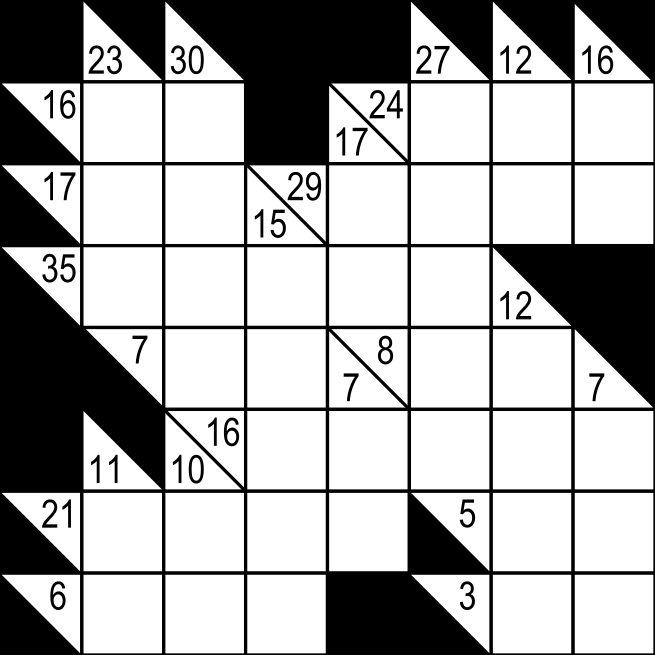
Main Difference
The main difference between Kakuro and Sudoku is that the Kakuro is a logic puzzle often referred to as a mathematical transliteration of the crossword and Sudoku is a logic number grid puzzle
-
Kakuro
Kakuro or Kakkuro (Japanese: カックロ) is a kind of logic puzzle that is often referred to as a mathematical transliteration of the crossword. Kakuro puzzles are regular features in many math-and-logic puzzle publications across the world. In 1966, Canadian Jacob E. Funk, an employee of Dell Magazines, came up with the original English name Cross Sums and other names such as Cross Addition have also been used, but the Japanese name Kakuro, abbreviation of Japanese kasan kurosu (加算クロス, “addition cross”), seems to have gained general acceptance and the puzzles appear to be titled this way now in most publications. The popularity of Kakuro in Japan is immense, second only to Sudoku among Nikoli’s famed logic-puzzle offerings.The canonical Kakuro puzzle is played in a grid of filled and barred cells, “black” and “white” respectively. Puzzles are usually 16×16 in size, although these dimensions can vary widely. Apart from the top row and leftmost column which are entirely black, the grid is divided into “entries”—lines of white cells—by the black cells. The black cells contain a diagonal slash from upper-left to lower-right and a number in one or both halves, such that each horizontal entry has a number in the black half-cell to its immediate left and each vertical entry has a number in the black half-cell immediately above it. These numbers, borrowing crossword terminology, are commonly called “clues”.
The objective of the puzzle is to insert a digit from 1 to 9 inclusive into each white cell such that the sum of the numbers in each entry matches the clue associated with it and that no digit is duplicated in any entry. It is that lack of duplication that makes creating Kakuro puzzles with unique solutions possible. Like Sudoku, solving a Kakuro puzzle involves investigating combinations and permutations. There is an unwritten rule for making Kakuro puzzles that each clue must have at least two numbers that add up to it, since including only one number is mathematically trivial when solving Kakuro puzzles.
At least one publisher includes the constraint that a given combination of numbers can only be used once in each grid, but still markets the puzzles as plain Kakuro.
Some publishers prefer to print their Kakuro grids exactly like crossword grids, with no labeling in the black cells and instead numbering the entries, providing a separate list of the clues akin to a list of crossword clues. (This eliminates the row and column that are entirely black.) This is purely an issue of image and does not affect either the solution nor the logic required for solving.
In discussing Kakuro puzzles and tactics, the typical shorthand for referring to an entry is “(clue, in numerals)-in-(number of cells in entry, spelled out)”, such as “16-in-two” and “25-in-five”. The exception is what would otherwise be called the “45-in-nine”—simply “45” is used, since the “-in-nine” is mathematically implied (nine cells is the longest possible entry, and since it cannot duplicate a digit it must consist of all the digits from 1 to 9 once). Curiously, both “43-in-eight” and “44-in-eight” are still frequently called as such, despite the “-in-eight” suffix being equally implied.
-
Sudoku
Sudoku (数独, sūdoku, digit-single) (, , , originally called Number Place) is a logic-based, combinatorial number-placement puzzle. In classic sudoku, the objective is to fill a 9×9 grid with digits so that each column, each row, and each of the nine 3×3 subgrids that compose the grid (also called “boxes”, “blocks”, or “regions”) contain all of the digits from 1 to 9. The puzzle setter provides a partially completed grid, which for a well-posed puzzle has a single solution.
Completed games are always an example of a Latin square, including an additional constraint on the contents of individual regions. For example, the same single integer may not appear twice in the same row, column, or any of the nine 3×3 subregions of the 9×9 playing board.
French newspapers featured variations of the Sudoku puzzles in the 19th century, and the puzzle has appeared since 1979 in puzzle books under the name Number Place. However, the modern Sudoku only began to gain widespread popularity in 1986 when it was published by the Japanese puzzle company Nikoli under the name Sudoku, meaning “single number”. It first appeared in a U.S. newspaper, and then The Times (London), in 2004, thanks to the efforts of Wayne Gould, who devised a computer program to rapidly produce unique puzzles.
-
Kakuro (noun)
A type of number puzzle, similar to a crossword but with numbers. Each “clue” is the sum of the digits to be placed in its group of squares, and no digit can be repeated within a group.
-
Sudoku (noun)
A type of puzzle whose completion requires each of typically nine rows and columns and each of as many usually square subregions to contain, without duplication, the digits from 1 to 9 (or the grid dimension).
